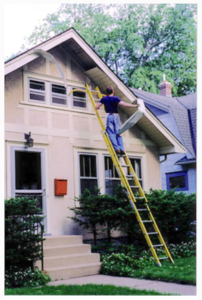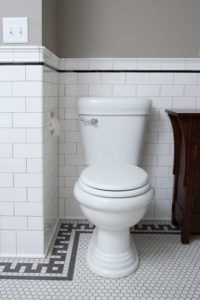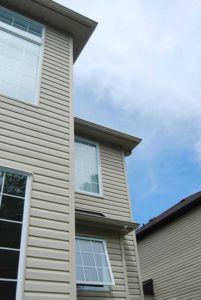Small Home Gazette, Fall 2017
Answers to Your Toughest Bungalow Questions: wrapping soffits in vinyl; cleaning tile
A: We will be up-front about the Bungalow Club’s perspective on the maintenance and repair of vintage homes. We believe original features should be repaired or replaced with the same materials they were built with, whenever possible. We do not advocate the use of materials such as vinyl or aluminum. In fact, we recommend against using them.
The reasons for this are many. Among them are the point you mention about losing character. Many “improvements” to older houses result in the gradual loss of historic character and detail. Each project strips away a bit of what makes a bungalow a bungalow, with the eventual result being a generic, featureless box. And even though manufacturers claim that vinyl products accurately mimic wood, they don’t. It’s easy to spot vinyl and aluminum house trim from a distance. No matter how expensive the product or how expert the installation, we think they make houses look cheap and flimsy.
Purveyors of vinyl often use the promise of a maintenance-free exterior at a reasonable cost to sell their product. But nothing is maintenance free, including vinyl. Vinyl will get dirty, and it will eventually discolor, separate and crack. Even a freshly painted house is maintenance free for a while. And while a paint job may need to be touched-up or refreshed every few years, the cost of that maintenance will generally be much less than applying vinyl.

Bungalow Club member Kevin Johnson strips aluminum trim from his bungalow. He and wife, Lisa, then restored the house’s trim and repainted it.
Another objection to vinyl is that it is vinyl—a petroleum-based product that is polluting to produce and doesn’t recycle or break down easily. It also gives off toxic fumes when it burns. The position of the International Association of Firefighters is: “Due to its intrinsic hazards, we support efforts to identify and use alternative building materials that do not pose as much risk as PVC to fire fighters, building occupants or communities.”
We understand that it’s impossible to live in today’s world without using plastics, but the Bungalow Club’s board of directors encourages minimizing its use, especially on houses.
Resources
Here are links to a couple of past articles in our newsletter, the Small Home Gazette, about homeowners who removed trim wrap from their houses and restored original features.
- “Insulation Elucidation”
tinyurl.com/yd56yvz5
- “Roof Revelation: One Couple’s Experience”
tinyurl.com/y9qh4ql8
While homeowners are flooded with advertising from businesses that extol the supposed virtues of vinyl siding and windows, one has to do some digging to find literature advocating the use of wood and paint. But it’s out there. We did a quick internet search and came up with the following:
- Preservation Brief 8: Aluminum and Vinyl Siding on Historic Buildings
National Park Service
tinyurl.com/ycuwcger
- “Vinyl Is Not Final”
Kansas Preservation
tinyurl.com/yctdssna
- “Vinyl Siding and the Historic House”
tinyurl.com/yc2ot9md
Q: What do I use to clean tile?
A: Make your own cleaner using environmentally friendly materials that are safe and cheap. See below.
 ¼ cup white vinegar
¼ cup white vinegar
2 tsp. Borax
3 ½ cups hot water
20 drops of essential oil (lavender or lemon)
¼ cup liquid dish soap
In a 32-ounce spray bottle, mix the vinegar, Borax and water thoroughly.
Add essential oil as desired. Add the dish soap last.
How to use: Once you mix up the formula, spray on to your tiles, stone or laminate surface. Using a paper towel or washcloth, wipe clean. For food that has hardened on to a surface, spray and let soak for a minute then wipe clean. In shower and bath settings, use after you have showered; let soak for a couple minutes then wipe clean or squeegee.
Tools to use to clean: Sponges and soft brushes are very effective to clean tiles. The glossy surface on tiles is called glaze and is a glass surface. Using abrasive tools will scratch the glazed surface of tiles and allow germs to collect and can turn to mold. Regular cleaning of your tile surfaces is recommended.
Text and photo used with permission of Clay Squared to Infinity, LLC, www.claysquared.com.












